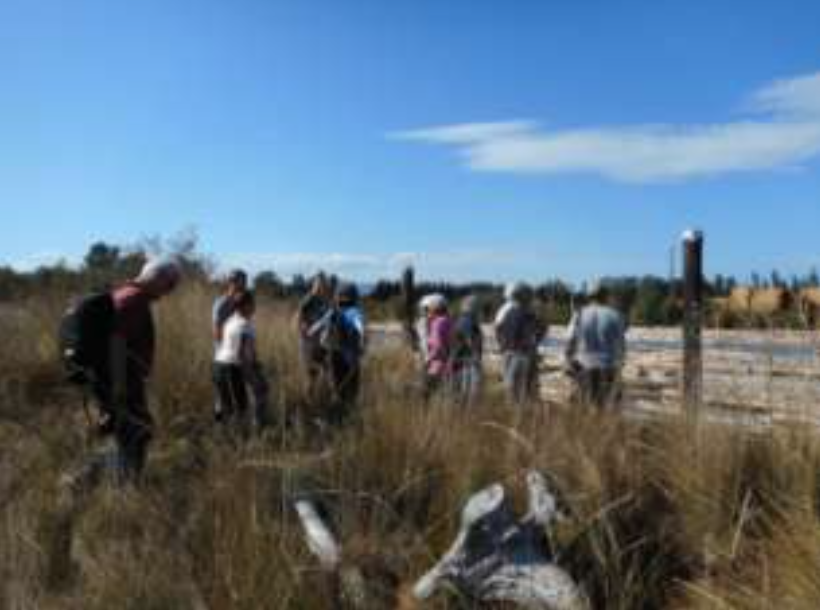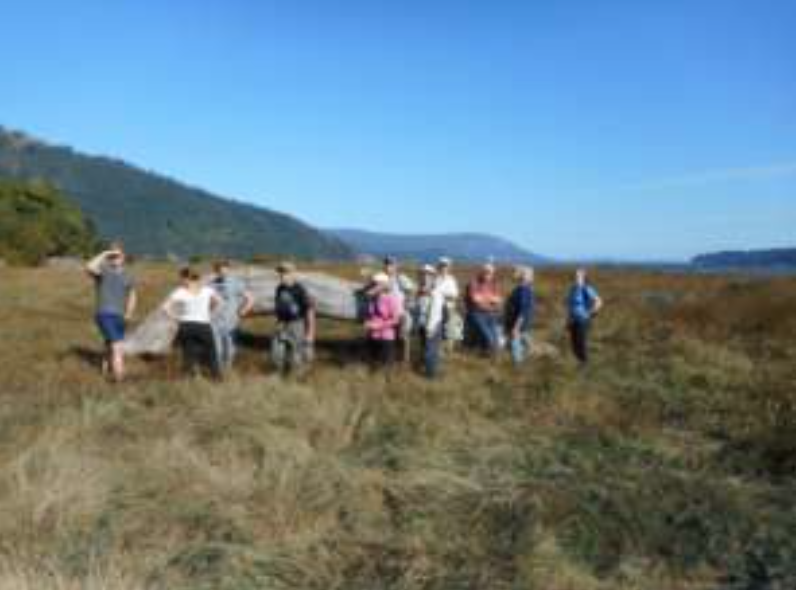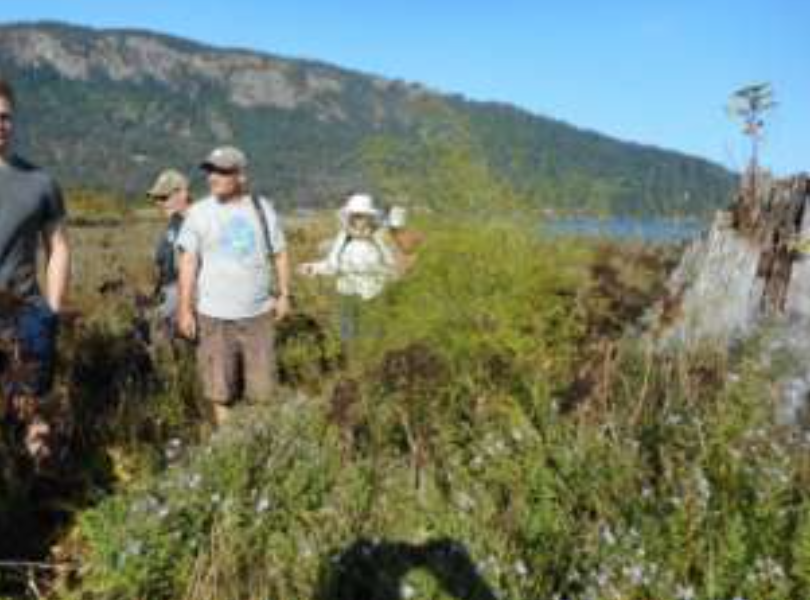Mariners Island Salt Marsh Recovery; Guided Tour
Salt-marsh Recovery Mariners Island Guided Walk
On the second day of September a group of CERCA members ventured out onto Mariners Island to explore and admire the amazing recovery of the salt marsh which CERCA jointly with Western Forest Products Limited (WFP) had rehabilitated and cleaned up in 2015. We briefly stopped by the mill pond which borders Mariners Island discussing impacts of log transport and storage on the estuary and the assistance received by WFP.
To access and traverse the salt-marsh numerous runnels and inter-tidal drainage channels had to be crossed. They are characteristic for salt-marshes and vital for the biological diversity of this ecosystem. Following the log removal the channels were cleaned with the help of summer students from BC Land Trust and returned to their former high productivity.
You may recall that the greater part of this salt-marsh which borders the Western Forest Products mill pond was covered by a solid layer of logs washed up onto the island over decades. CERCA with financial assistance of the DFO and Western Forest Products spearheaded and implemented the removal of the logs and large woody debris and a final clean-up of tons of garbage which had accumulated over time on this precious ecosystem. If you are interested in details check out the following links on our website.
A pre-inventory implemented jointly with Ducks Unlimited revealed an astounding number of almost 20 Thousand logs and large woody debris to be dealt with. It took a skilled excavator operator more than a month to stockpile usable logs at the shore of the mill pond and to pile up woody debris already too de-composed for transport into mounds mixed with topsoil in order to create an important additional habitat feature enhancing the biological diversity of Mariners Island. Hundreds of usable logs were sold to Cedar Harmac Pulp Mill for chipping and the revenue received used to pay for the project and other initiatives in the estuary.
Following the log removal CERCA jointly with Ducks Unlimited conducted a vegetation survey to create the baselines for monitoring vegetation recovery. Monitoring the recovery process has taken place for the past three years. As shown by the following photos recovery has been remarkable and fast. Numerous native species have re-colonized the area formerly covered by logs. We now find patches of sedges and rushes which are particularly important in salt-marshes. Unlike many shrub species, they have shallow spreading surface roots, which bind the soil and reduce erosion. Rushes and sedges are also pivotal to water quality improvement of marshes. Their soil binding properties and growth habit means they are excellent at slowing the rate of water flow and trapping sediment within waterways. The root systems of many species also help to oxygenate the water and sediment by ‘leaking’ excess oxygen through their roots. This is important for nutrient transformation and for providing microhabitat for invertebrate fauna. Their seed pods are a vital food source for overwintering birds.
By now the reclaimed salt-marsh of Mariners Island is a showcase of ecosystem resilience and successful restoration efforts as demonstrated by the following photos "Before and After".
The mounds of decomposed woody debris mixed with top soil created as special habitat feature along the shrubby vegetation belt bordering the mill pond have started to green up. We encountered numerous shrub species, herbs and other vegetation colonizing the mounds providing habitat to many critters from invertebrates to mammals and birds (see photos below).
Log and woody debris removal focused on saw logs only. Saw logs with cut off ends are detrimental to salt marsh vegetation destroying critical food sources for birds and other critters by rolling across vegetation, being squished around by king tides, thus burying and flattening seed pods of rushes and sedges, an important food source for many species. In contrast, trees with attached roots and also stumps washed into the estuary by the tributaries and settling in salt-marshes and mudflats, firmly anchoring in the soil, were left as important habitat requisites providing multiple benefits such as perches for birds and habitat for other species.
The lower photo to the right shows an asparagus plant, testimony to the past uses of all of the estuary's salt marshes for agriculture, as cow pastures and hay fields. All salt marshes of the estuary had been converted or affected since the 1850s when the first dykes were built to create agricultural land by keeping salt water out. Meanwhile most of the dykes have been breached giving the salt marshes a chance to recover naturally. Much of the area is now under protection. Unfortunately numerous agronomic species left over from past alien uses are still found throughout the salt marshes. Some are aggressive invaders such as Canary grass, black berries and scotch broom suppressing and replacing native species.
Walking along the shoreline of Mariners Island which is formed by the important ecotone between the inter-tidal mudflats and the salt marsh proper, we discussed the Key role of salt-marshes in preventing erosion by stabilizing the soil through the sophisticated root system of pioneering vascular plant species adapted to the high salinity of sea water. A remarkable evolutionary achievement of vascular plants in itself!
Unfortunately we also found numerous cut logs washed up again onto the shoreline. They most likely originate from the log booms destined for the WFP Mill in the estuary. This happens throughout the year, but primarily during spring and fall storms. The logs should be removed while still accessible. Once washed up onto the salt marsh removal is difficult causing a lot of damage to the vegetation in the process.
We will report the loose logs (14 logs counted along the shoreline facing the mudflats) to WFP to be removed prior to the fall storms which may wash them onto the salt marshes. CERCA is keeping track of loose logs floating around in the estuary and reports such sightings on a regular basis to WFP which has an agreement with their contractor Falt Towing to remove the logs. In accordance with their License of Occupation Agreement with the BC Government Western Forest Products is obliged to remove the loose logs.
In summary, CERCA's Mariners Island salt marsh rehabilitation project implemented in 2015 has been a great success. This guided walk across the salt-marsh was well received by our members, an encouragement to offer such opportunity again in 2019. This report will also be provided to our main sponsors and partners of this project.
Dr. Goetz Schuerholz
CERCA Chair













